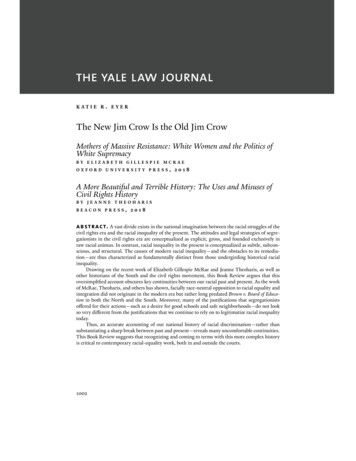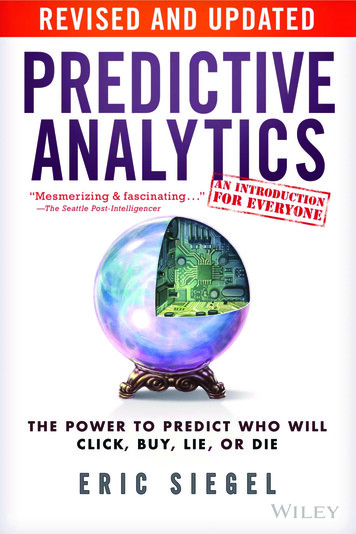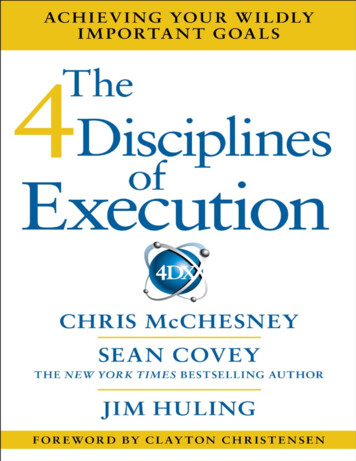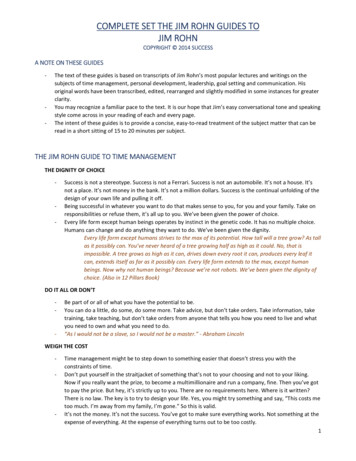
Transcription
Eric & Jim’s 20 Tips forSmall-Business Success1. Not everyone is cut out to be a small-business owner. Takethe time to explore whether you’re compatible with runningyour own business. Some people are happier (and better offfinancially) on the other end of a paycheck.2. Get your personal finances in order. Before you jumpinto the entrepreneurial fray, get your own money matterssquared away.3. Pick your niche. Take stock of your skills, interests, andemployment history to select the business best suited to you.Choosing a niche that you can be passionate about will alsohelp improve your chances of succeeding. Remember: Manysmall-business owners succeed in businesses that are hardlyunique or innovative.4. Benefit from your business plan. The exercise of creatingyour business plan pays dividends. Answer the toughquestions now, before the meter is running.5. Don’t think you need bankers and investors at theoutset. The vast majority of small-business start-ups arebootstrapped (self-financed).6. Know the hats you wear best. In the early months and yearsof your business, you’ll have to acquire many skills. Gain thebackground you need to oversee all facets of your businesswell, but determine what tasks you should outsource or hireemployees to manage.7. Remember that “nothing happens until a sale is made.” Howmany good products go nowhere because they don’t reachthe shelves? Sales are what will drive your business. You needa crackerjack marketing plan that details how you intend topackage, promote, distribute, price, and sell your product orservice.8. You have to see a customer to know one. No matter howbusy you are, especially in the early years of your business,be sure to spend at least 25 percent of your time withcustomers. You can’t make the right business decisionswithout understanding the customer’s viewpoint.9. Solve your customers’ problems. The best way to satisfy yourcustomers is not by selling them products or services butby providing solutions to their problems. Understand thedifference.
10. Keep in mind that quality takes only moments to lose andyears to regain. Quality isn’t a destination but rather anever-ending journey. After you’ve strayed from quality’spath, your journey may be sidetracked forever.11. Put profitability first and rewards second. Beware of thesmall business that treats itself to hefty salaries, high-pricedconsultants, and waterfalls in the lobby. In small business,profitability must come first. In order to understandprofitability, you must first learn how to measure your cashflow and understand your key financial ratios.12. Hire superstars. If you intend to create a growing business,your number-one duty is to assemble a team of superstaremployees in your gamebreaker positions.13. Don’t go it alone. Tap into resources such as small-businesspeers, mentors, and trade associations that can help takesome of the energy-draining trial and error out of starting andrunning your business.14. Remember that vendors are partners, too. A good vendor isas important to your business as a good customer. Treat yourvendors like customers and watch the partnerships grow.15. Make use of benefits. The most valuable long-term benefityou can offer yourself and your employees is a retirementsavings plan. Also learn how to provide insurance and otherbenefits and cut your tax bill at the same time.16. Ignore regulatory issues at your peril. Federal, state, andlocal government agencies require an array of licenses,registrations, and permits. Obey them or face stiff penalties,including possible closure of your business.17. Know the tax laws. Invest in understanding tax issues thataffect your small business. You can avoid trouble and, at thesame time, legally slice thousands of dollars off your tax bill ifyou know the right moves.18. It’s the people, stupid! Whatever happens to a small businesshappens at the hands of the people who work it and work for it.19. Fast, good, or cheap — pick any two. Serious trouble awaitsthose who attempt to be all things to the marketplace. Focuson what you do best.20. Develop a passion for learning. As your business changesand grows, you need to change and grow along with it —particularly as you transition to manager. One commondenominator can be found in all successful businessowners — a passion for learning.
Small BusinessFORDUMmIES‰4THEDITIONby Eric Tyson and Jim Schell
Small Business For Dummies , 4th EditionPublished byJohn Wiley & Sons, Inc.111 River St.Hoboken, NJ 07030-5774www.wiley.comCopyright 2012 by Eric Tyson and Jim SchellPublished by John Wiley & Sons, Inc., Hoboken, New JerseyPublished simultaneously in CanadaNo part of this publication may be reproduced, stored in a retrieval system or transmitted in any form orby any means, electronic, mechanical, photocopying, recording, scanning or otherwise, except as permitted under Sections 107 or 108 of the 1976 United States Copyright Act, without the prior written permission of the Publisher. Requests to the Publisher for permission should be addressed to the PermissionsDepartment, John Wiley & Sons, Inc., 111 River Street, Hoboken, NJ 07030, (201) 748-6011, fax (201) 7486008, or online at http://www.wiley.com/go/permissions.Trademarks: Wiley, the Wiley logo, For Dummies, the Dummies Man logo, A Reference for the Rest of Us!,The Dummies Way, Dummies Daily, The Fun and Easy Way, Dummies.com, Making Everything Easier, andrelated trade dress are trademarks or registered trademarks of John Wiley & Sons, Inc., and/or its affiliates in the United States and other countries, and may not be used without written permission. All othertrademarks are the property of their respective owners. John Wiley & Sons, Inc., is not associated withany product or vendor mentioned in this book.LIMIT OF LIABILITY/DISCLAIMER OF WARRANTY: THE PUBLISHER AND THE AUTHOR MAKE NOREPRESENTATIONS OR WARRANTIES WITH RESPECT TO THE ACCURACY OR COMPLETENESS OFTHE CONTENTS OF THIS WORK AND SPECIFICALLY DISCLAIM ALL WARRANTIES, INCLUDING WITHOUT LIMITATION WARRANTIES OF FITNESS FOR A PARTICULAR PURPOSE. NO WARRANTY MAY BECREATED OR EXTENDED BY SALES OR PROMOTIONAL MATERIALS. THE ADVICE AND STRATEGIESCONTAINED HEREIN MAY NOT BE SUITABLE FOR EVERY SITUATION. THIS WORK IS SOLD WITH THEUNDERSTANDING THAT THE PUBLISHER IS NOT ENGAGED IN RENDERING LEGAL, ACCOUNTING, OROTHER PROFESSIONAL SERVICES. IF PROFESSIONAL ASSISTANCE IS REQUIRED, THE SERVICES OFA COMPETENT PROFESSIONAL PERSON SHOULD BE SOUGHT. NEITHER THE PUBLISHER NOR THEAUTHOR SHALL BE LIABLE FOR DAMAGES ARISING HEREFROM. THE FACT THAT AN ORGANIZATIONOR WEBSITE IS REFERRED TO IN THIS WORK AS A CITATION AND/OR A POTENTIAL SOURCE OF FURTHER INFORMATION DOES NOT MEAN THAT THE AUTHOR OR THE PUBLISHER ENDORSES THE INFORMATION THE ORGANIZATION OR WEBSITE MAY PROVIDE OR RECOMMENDATIONS IT MAY MAKE.FURTHER, READERS SHOULD BE AWARE THAT INTERNET WEBSITES LISTED IN THIS WORK MAY HAVECHANGED OR DISAPPEARED BETWEEN WHEN THIS WORK WAS WRITTEN AND WHEN IT IS READ.For general information on our other products and services, please contact our Customer CareDepartment within the U.S. at 877-762-2974, outside the U.S. at 317-572-3993, or fax 317-572-4002.For technical support, please visit www.wiley.com/techsupport.Wiley publishes in a variety of print and electronic formats and by print-on-demand. Some materialincluded with standard print versions of this book may not be included in e-books or in print-on-demand.If this book refers to media such as a CD or DVD that is not included in the version you purchased, youmay download this material at http://booksupport.wiley.com. For more information about Wileyproducts, visit www.wiley.com.Library of Congress Control Number is available from the Publisher.ISBN 978-1-118-08372-7 (pbk); ISBN 978-1-118-21369-8 (ebk); ISBN 978-1-118-21371-1 (ebk);ISBN 978-1-118-21381-0 (ebk)Manufactured in the United States of America10 9 8 7 6 5 4 3 2 1
About the AuthorsEric Tyson, MBA, has been a personal financial writer, lecturer, and counselor for the past 25 years. As his own boss, Eric has worked with and taughtpeople from a myriad of income levels and backgrounds, so he knows thesmall-business ownership concerns and questions of real folks just like you.After toiling away for too many years as a management consultant to behemothfinancial-service firms, Eric decided to take his knowledge of the industry andcommit himself to making personal financial management accessible to everyone. Despite being handicapped by a joint BS in Economics and Biology fromYale and an MBA from Stanford, Eric remains a master at “keeping it simple.”An accomplished freelance personal-finance writer, Eric is the author orcoauthor of numerous other For Dummies national bestsellers on personalfinance, investing, for seniors, and home buying and is a syndicated columnist.His Personal Finance For Dummies won the Benjamin Franklin Award for BestBusiness Book.Eric’s work has been critically acclaimed in hundreds of publications andprograms, including Newsweek, The Los Angeles Times, The Chicago Tribune,Kiplinger’s Personal Finance Magazine, The Wall Street Journal, Bottom LinePersonal, as well as NBC’s Today show, ABC, CNBC, PBS’s Nightly BusinessReport, CNN, FOX-TV, CBS national radio, Bloomberg Business Radio, andBusiness Radio Network. His website is www.erictyson.com.Jim Schell has not always been a grizzled veteran of the small-business wars,contrary to what some people may think. Raised in Des Moines, Iowa, andearning a BA in Economics at the University of Colorado, Jim served in the U.S.Air Force in Klamath Falls, Oregon. Jim’s entrepreneurial genes eventually surfacedwhen he and three Minneapolis friends started The Kings Court, at the time thenation’s first racquetball club. Two years later, Jim bought General Sports, Inc.,a struggling sporting-goods retailer and wholesaler. After another two years, hestarted National Screenprint, and, finally, he partnered with an ex-employee inFitness and Weight Training Corp. Each of the start-ups was bootstrapped, andeach was privately held. For a period of exhausting years, Jim involved himselfin the management of all four businesses at the same time. His third business,National Screenprint, ultimately grew to 25 million in sales and 200 employees.Relocating to San Diego, Jim began a long-simmering writing career, authoringfour books (The Brass Tacks Entrepreneur, Small Business ManagementGuide, The Small Business Answer Book, and Understanding Your FinancialStatements) and numerous columns for business and trade magazines.Citing culture shock, Jim and his wife, Mary — a sales trainer and longtimebusiness partner — relocated to Bend, Oregon, where he continued hiswriting career. In 1996, he kicked off his fifth start-up, Opportunity Knocks(OK), a nonprofit that uses volunteers to organize, administrate, and facilitate
the formation of small-business owners into teams that will serve as amember’s board of advisors. In the last five years, Jim has also founded threeadditional nonprofits and participated in the turnaround of two more. Jimhas three grown sons — Jim, Todd, and Mike — and five grandchildren.DedicationsFrom Eric: To my wife, Judy; to my family, especially my parents, Charlesand Paulina; to my friends; and to my counseling clients and students of mycourses, for teaching me how to teach them about managing their finances.From Jim: This book is dedicated to The Rocky Road, and to all thosefriends, employees, and customers who have traversed it with me. Most ofall, it is dedicated to my wife, Mary, without whom The Rocky Road wouldhave been The Dead End.Authors’ AcknowledgmentsMany people contribute to the birth of a book, and this book is no exception.First, Eric would like to express his deep debt of gratitude to James Collins,who inspired him when he was a young and impressionable business schoolstudent. Jim encouraged Eric to try to improve some small part of the businessworld by being an entrepreneur and focusing solely on what customersneeded rather than on what made the quickest buck.The technical reviewer for this book, Lindsay Stevens, helped improve ourbook, and we are thankful for that.Thanks to all the good people in the media and other fields who have takenthe time to critique and praise our previous writing so that others may knowthat it exists and is worth reading. And to those who may not open the bookbecause of its bright yellow color and low-brow title, “You can’t judge a bookby its cover!” Now that we’ve got your attention, flip through the pages andfind out why readers everywhere know and trust books For Dummies.And a final and heartfelt thanks to all the people on the front lines and behindthe scenes who helped to make this book and Eric’s others a success. A biground of applause, please, for Elizabeth Rea as project editor and AmandaLangferman as copy editor. Their attention to detail and ability to ask goodquestions helped make this book the best that it could be. Thanks also tothe Composition, Graphics, Proofreading, and Indexing staffs for their greatefforts in producing this book.P.S. Thanks to you, dear reader, for buying this book.
More Bestselling For Dummies Titlesby Eric TysonInvesting For Dummies A Wall Street Journal bestseller, this book walks you through how to buildwealth in stocks, real estate, and small business as well as other investments.Personal Finance For Dummies The bestselling Personal Finance For Dummies has helped countless readersbudget their funds successfully, rein in debt, and build a strong foundationfor the future. Eric Tyson combines his time-tested financial advice alongwith new strategies that reflect changing market conditions, giving you an allencompassing guide to taking an honest look at your current financial healthand setting realistic goals for the future.Personal Finance in Your 20s For Dummies This hands-on, friendly guide provides you with the targeted financial adviceyou need to establish firm financial footing in your 20s and to secure yourfinances for years to come. When it comes to protecting your financial future,starting sooner rather than later is the smartest thing you can do.Home Buying For Dummies America’s #1 real estate book includes coverage of online resources inaddition to sound financial advice from Eric Tyson and frontline real estateinsights from industry veteran Ray Brown. Also available from America’sbest-selling real estate team of Tyson and Brown — House Selling ForDummies and Mortgages For Dummies.Real Estate Investing For Dummies Real estate is a proven wealth-building investment, but many people don’tknow how to go about making and managing rental property investments.Real estate and property management expert Robert Griswold and Eric Tysoncover the gamut of property investment options, strategies, and techniques.
Publisher’s AcknowledgmentsWe’re proud of this book; please send us your comments at http://dummies.custhelp.com.For other comments, please contact our Customer Care Department within the U.S. at 877-762-2974,outside the U.S. at 317-572-3993, or fax 317-572-4002.Some of the people who helped bring this book to market include the following:Acquisitions, Editorial, and VerticalWebsitesComposition ServicesProject Editor: Elizabeth Rea(Previous Edition: Alissa Schwipps)Project Coordinator: Patrick RedmondLayout and Graphics: Carl Byers,Julie TrippettiAcquisitions Editor: Erin Calligan MooneyProofreader: Laura BowmanCopy Editor: Amanda M. LangfermanIndexer: Palmer Publishing Services(Previous Edition: Josh Dials, Kelly Ewing)Assistant Editor: David LuttonEditorial Program Coordinator: Joe NiesenTechnical Editor: Lindsay StevensEditorial Manager: Michelle HackerEditorial Assistant: Alexa KoschierCover Photo: iStockphoto.com/Ivan KmitCartoons: Rich Tennant(www.the5thwave.com)Publishing and Editorial for Consumer DummiesKathleen Nebenhaus, Vice President and Executive PublisherKristin Ferguson-Wagstaffe, Product Development DirectorEnsley Eikenburg, Associate Publisher, TravelKelly Regan, Editorial Director, TravelPublishing for Technology DummiesAndy Cummings, Vice President and PublisherComposition ServicesDebbie Stailey, Director of Composition Services
Contents at a GlanceIntroduction. 1Part I: Becoming an Entrepreneur. 9Chapter 1: Is Small Business for You?. 11Chapter 2: Laying Your Personal Financial Foundation. 27Chapter 3: Finding Your Niche. 41Chapter 4: First Things First: Crafting Your Business Plan. 57Chapter 5: Making Financing, Ownership, and Organizational Decisions. 77Part II: Buying an Existing Business. 105Chapter 6: Exploring Buying a Business. 107Chapter 7: Finding the Right Business to Buy. 117Chapter 8: Evaluating a Business to Buy. 131Chapter 9: Negotiating Terms and Sealing the Deal. 149Part III: Running a Successful Small Business. 161Chapter 10: The Owner’s Responsibilities in the Start-Up and Beyond. 163Chapter 11: Marketing: Products, Pricing, Distribution, Promotion, and Sales. 191Chapter 12: Tapping Technology. 221Chapter 13: Keeping Your Customers Loyal. 233Chapter 14: Managing Profitability and Cash. 245Chapter 15: Learning from the Experiences of Others. 271Part IV: Keeping Your Business in Business. 283Chapter 16: Finding and Keeping Superstar Employees. 285Chapter 17: Providing Employee Benefits. 313Chapter 18: Handling Regulatory and Legal Issues. 333Chapter 19: Mastering Small-Business Taxes. 347Chapter 20: Cultivating a Growing Business. 361Part V: The Part of Tens. 381Chapter 21: Ten Mistakes You Don’t Want to Make. 383Chapter 22: Ten Tips for Small-Business Success. 391Index. 399
Table of ContentsIntroduction. 1About This Book. 2Conventions Used in This Book. 3What You’re Not to Read. 3Foolish Assumptions. 4How This Book Is Organized. 4Part I: Becoming an Entrepreneur. 4Part II: Buying an Existing Business. 5Part III: Running a Successful Small Business. 5Part IV: Keeping Your Business in Business. 6Part V: The Part of Tens. 7Icons Used in This Book. 7Where to Go from Here. 8Part I: Becoming an Entrepreneur. 9Chapter 1: Is Small Business for You? . . . . . . . . . . . . . . . . . . . . . . . . . . . 11Defining Small Business. 11Small (and large) business basics. 12Financial basics: The same whether you’re big or small. 13Small business: Role model for big business. 14Different people and businesses, similar issues. 14Our definition of a small-business owner. 16Do You Have the Right Stuff?. 17Getting started with the instructions. 17Answering the questions. 18Scoring the test. 19Analyzing your results. 20Identifying the Pros and Cons of Owning a Small Business. 21The reasons to own. 22The reasons not to own. 23Exploring Alternatives to Starting a Business. 25Chapter 2: Laying Your Personal Financial Foundation . . . . . . . . . . . . 27Getting Your Financial Ducks in a Row. 27Cutting the umbilical cord. 28Improving your business survival odds. 28Maintaining harmony on the home front. 29
xiiSmall Business For Dummies, 4th EditionCreating Your Money To-Do List. 30Assess your financial position and goals. 30Shrink your spending. 34Build up your cash reserves. 34Stabilize income with part-time work. 35Assessing and Replacing Benefits. 36Retirement savings plans and pensions. 36Health insurance. 37Disability insurance. 37Life insurance. 38Dental, vision, and other insurance. 38Social Security taxes. 39Time off. 39Managing Your Personal Finances Post-Launch. 40Chapter 3: Finding Your Niche . . . . . . . . . . . . . . . . . . . . . . . . . . . . . . . . . 41Why You Don’t Need a New Idea to Be Successful. 41Inventing Something New. 43Say yes to useful invention resources. 43Run away from invention promotion firms. 44Choosing Your Business. 46Consider your category. 46Take advantage of accidental opportunities. 47Inventory your skills, interests, and job history. 48Narrow your choices. 50Go in search of fast growth. 52Take advantage of government resources. 54Recognizing Your Number One Asset — You. 55Chapter 4: First Things First: Crafting Your Business Plan . . . . . . . . . 57Your Mission: Impossible If You Fail to Define It. 57Writing your mission statement. 58Keeping your mission in people’s minds. 60Your Business Plan: Don’t Start Up without It. 60Using your business plan as a road map. 61Finding financing with your business plan. 62Writing Your Business Plan. 62Part 1: Business description. 63Part 2: Management. 65Part 3: Marketing plan. 66Part 4: Operations. 70Part 5: Risks. 71Part 6: Financial management plan. 73Keeping Your Plan Current. 75
Table of ContentsChapter 5: Making Financing, Ownership,and Organizational Decisions . . . . . . . . . . . . . . . . . . . . . . . . . . . . . . . . . . 77Determining Your Start-Up Cash Needs. 77Using Your Own Money: Bootstrapping. 80Profiling bootstrappers. 81Tapping into bootstrapping sources. 81Outsourcing for Your Capital Needs. 84Banking on banks. 84Getting money from nonbanks. 86Exploring Ownership Options. 90You as the sole owner. 92Sharing ownership with partners or minority shareholders. 93Deciding between sole and shared ownership. 94Going public: Cashing in. 95Deciding Whether to Incorporate. 96Weighing unincorporated options. 97Considering incorporated business entities. 99Part II: Buying an Existing Business. 105Chapter 6: Exploring Buying a Business . . . . . . . . . . . . . . . . . . . . . . . . 107Understanding Why to Buy a Business. 107To reduce start-up hassles and headaches. 108To lessen your risk. 109To increase profits by adding value. 109To establish cash flow. 110To capitalize on someone else’s good idea. 110To open locked doors. 111To inherit an established customer base. 111Knowing When You Shouldn’t Buy. 111You dislike inherited baggage. 111You’re going to skimp on inspections. 112You lack capital. 112You think you’ll miss out on the satisfactionof creating a business. 113Recognizing Prepurchase Prerequisites. 114Business experience and training. 114Down-payment money. 115Chapter 7: Finding the Right Business to Buy . . . . . . . . . . . . . . . . . . . 117Defining Your Business-Buying Appetite. 117Generating Leads. 119Perusing publications.
Small-Business Success 1. Not everyone is cut out to be a small-business owner. . Sales are what will drive your business. You need a crackerjack marketing plan that details how you intend to package, promote, distribute, price, and sell your product or . Small Business For Dummies , 4th











